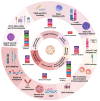The 'Oma's of the Gammas-Cancerogenesis by γ-Herpesviruses
- PMID: 39772235
- PMCID: PMC11680331
- DOI: 10.3390/v16121928
The 'Oma's of the Gammas-Cancerogenesis by γ-Herpesviruses
Abstract
Epstein-Barr virus (EBV) and Kaposi's sarcoma-associated herpesvirus (KSHV), which are the only members of the gamma(γ) herpesviruses, are oncogenic viruses that significantly contribute to the development of various human cancers, such as Burkitt's lymphoma, nasopharyngeal carcinoma, Hodgkin's lymphoma, Kaposi's sarcoma, and primary effusion lymphoma. Oncogenesis triggered by γ-herpesviruses involves complex interactions between viral genetics, host cellular mechanisms, and immune evasion strategies. At the genetic level, crucial viral oncogenes participate in the disruption of cell signaling, leading to uncontrolled proliferation and inhibition of apoptosis. These viral proteins can modulate several cellular pathways, including the NF-κB and JAK/STAT pathways, which play essential roles in cell survival and inflammation. Epigenetic modifications further contribute to EBV- and KSHV-mediated cancerogenesis. Both EBV and KSHV manipulate host cell DNA methylation, histone modification, and chromatin remodeling, the interplay of which contribute to the elevation of oncogene expression and the silencing of the tumor suppressor genes. Immune factors also play a pivotal role in the development of cancer. The γ-herpesviruses have evolved intricate immune evasion strategies, including the manipulation of the major histocompatibility complex (MHC) and the release of cytokines, allowing infected cells to evade immune detection and destruction. In addition, a compromised immune system, such as in HIV/AIDS patients, significantly increases the risk of cancers associated with EBV and KSHV. This review aims to provide a comprehensive overview of the genetic, epigenetic, and immune mechanisms by which γ-herpesviruses drive cancerogenesis, highlighting key molecular pathways and potential therapeutic targets.
Keywords: Epstein–Barr; Kaposi’s sarcoma; antiviral; co-infection; epigenetic; gamma herpesviruses; immune evasion; lymphoma; oncogene; vaccine.
Conflict of interest statement
The authors declare no conflicts of interest.
Figures







Similar articles
-
Ubiquitin-Mediated Effects on Oncogenesis during EBV and KSHV Infection.Viruses. 2024 Sep 26;16(10):1523. doi: 10.3390/v16101523. Viruses. 2024. PMID: 39459858 Free PMC article. Review.
-
Herpesvirus Epigenetic Reprogramming and Oncogenesis.Annu Rev Virol. 2020 Sep 29;7(1):309-331. doi: 10.1146/annurev-virology-020420-014025. Annu Rev Virol. 2020. PMID: 32991266 Review.
-
Non-Coding RNAs and Immune Evasion in Human Gamma-Herpesviruses.Viruses. 2025 Jul 17;17(7):1006. doi: 10.3390/v17071006. Viruses. 2025. PMID: 40733622 Free PMC article. Review.
-
Manipulation of the host cell membrane by human γ-herpesviruses EBV and KSHV for pathogenesis.Virol Sin. 2016 Oct;31(5):395-405. doi: 10.1007/s12250-016-3817-2. Epub 2016 Sep 12. Virol Sin. 2016. PMID: 27624182 Free PMC article. Review.
-
Understanding Metabolic Pathway Rewiring by Oncogenic Gamma Herpesvirus.J Microbiol Biotechnol. 2024 Nov 28;34(11):2143-2152. doi: 10.4014/jmb.2407.07039. Epub 2024 Aug 30. J Microbiol Biotechnol. 2024. PMID: 39403716 Free PMC article. Review.
Cited by
-
Lymphoproliferations in People Living with HIV: Oncogenic Pathways, Diagnostic Challenges, and New Therapeutic Opportunities.Cancers (Basel). 2025 Jun 22;17(13):2088. doi: 10.3390/cancers17132088. Cancers (Basel). 2025. PMID: 40647389 Free PMC article. Review.
-
The role of pioneering transcription factors, chromatin accessibility and epigenetic reprogramming in oncogenic viruses.Front Microbiol. 2025 Jun 16;16:1602497. doi: 10.3389/fmicb.2025.1602497. eCollection 2025. Front Microbiol. 2025. PMID: 40589575 Free PMC article. Review.
-
Current State of AIDS-Related Malignant Lymphoma.Viruses. 2025 Jun 26;17(7):904. doi: 10.3390/v17070904. Viruses. 2025. PMID: 40733522 Free PMC article. Review.
References
-
- Britt W. Virus entry into host, establishment of infection, spread in host, mechanisms of tissue damage. In: Arvin A., Campadelli-Fiume G., Mocarski E., Moore P.S., Roizman B., Whitley R., Yamanishi K., editors. Human Herpesviruses: Biology, Therapy, and Immunoprophylaxis. Cambridge University Press; Cambridge, UK: 2007. - PubMed
Publication types
MeSH terms
LinkOut - more resources
Full Text Sources
Research Materials

